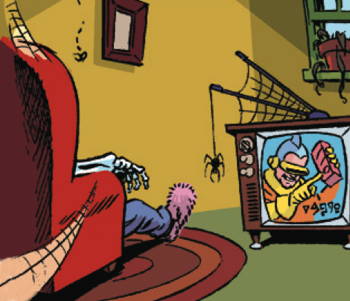April 2020
April 6, 2020
MONAD Studio - 3D-printed, Piezoelectric Violin
Posted By: Paul - Mon Apr 06, 2020 -
Comments (2)
Category: Inventions, Music, Technology
April 5, 2020
Camera Hat
John L. Johnson of Pinehurst, Washington obtained a patent for his "camera support" in 1945. Patent No. 2,369,829. The support provided a way to conceal a camera inside a hat.I wonder if the patent illustration was a self-portrait.

Posted By: Alex - Sun Apr 05, 2020 -
Comments (2)
Category: Inventions, Patents, Photography and Photographers, 1940s
Urban Daredevil
REYNOLDS, J., PERFORMING ACROBATIC AND BALANCING ACTS ON HIGH CORNICE ABOVE 9TH STREET, N.W


Source.
Posted By: Paul - Sun Apr 05, 2020 -
Comments (3)
Category: Daredevils, Stuntpeople and Thrillseekers, 1910s
April 4, 2020
Three-Faced Doll
Introduced in 1961, her name was "Hedda-Get-Bedda." Twisting a knob changed her face from sick, to well, to sleepy.I'm surprised no one ever came out with a similar, Exorcist-themed doll. She could have been happy, sleeping, or demonically possessed.

Allentown Morning Call - Sep 29, 1961
Posted By: Alex - Sat Apr 04, 2020 -
Comments (2)
Category: Toys, 1960s
The Mashuganishi Yogi

Use embedded player, or go to the source.
Posted By: Paul - Sat Apr 04, 2020 -
Comments (5)
Category: Humor, Parody, Satire, Stereotypes and Cliches, 1960s, India
April 3, 2020
Geraldine and Ricky

Geraldine Ragan (nee Murray) developed her Christian ventriloquism act in the 1960s while she was still a teenager. She had Ricky specially made for her. Some details from the Opelousas Daily World (Feb 16, 1969):
This new partner was named Ricky. (She had a very special friend whose name was Ricky.) The new partner, Ricky, was built with brown hair, large brown eyes and an even broader smile. He could move in all of the ways a human can as well as in a few ways that are characteristic of him alone.
His favorite subject is girls — as Geraldine puts it, "with a capital G". He loves them and is always willing to flirt with them or sing them a song.
The only thing Ricky can't do is keep a secret. He has received a great deal of notorious fans for his inability to keep the slightest confidence. All of these fine attributes combine to make Ricky a real live young man rather than a simple doll.

There are reports that Geraldine was still performing, as of 2014. I don't know if she's now finally retired.
Posted By: Alex - Fri Apr 03, 2020 -
Comments (6)
Category: Puppets and Automatons
Follies of the Madmen #471
Posted By: Paul - Fri Apr 03, 2020 -
Comments (4)
Category: Addictions, Business, Advertising, Innuendo, Double Entendres, Symbolism, Nudge-Nudge-Wink-Wink and Subliminal Messages, Tobacco and Smoking, 1960s
April 2, 2020
Do Beavers Rule on Mars?
In the May 1930 issue of Popular Science magazine, Thomas Elway advanced the unusual hypothesis that Mars was inhabited by a race of beavers. His idea was subsequently reported in many newspapers.As far as I can tell, Elway wasn't actually a scientist. He was a journalist. So perhaps one shouldn't attach too much weight to his opinion. Still, he gets points for creativity.

Semi-Weekly Spokesman Review - Oct 12, 1930
Elway's argument was based on the assumption (widespread at the time) that there was plant life on Mars. Therefore, animal life was also considered possible. His reasoning then proceeded as follows:
This lack of manlike life is precisely what a biologist would expect. Man and man's active mind are believed to be products of the Great Ice Age, for that time of stress and competition on earth is what is supposed to have turned mankind's anthropoid ancestors into men. The period of ice and cold over wide areas of the earth was caused, at least in part, by the elevation of continents and mountain ranges. On Mars, no mountain ranges exist, and it probably never had an Ice Age.
It is on these hypotheses that science bases its assumption that there is no human intelligence on Mars, and that animal life on the planet is still in the age of instinct. The thing to expect on Mars, then, is a fish life much like that on earth, the emergence of this fish life onto the land, and the evolution of these Martian land-fishes into retilelike creatures. Finally, animals resembling the earth's present rodents like rats, squirrels, and beavers would make their appearance.
The chief reason to expect this final change of Martian retiles into primitive mammals lies in the fact that on earth this evolution seems to have been forced by changeable weather. And Mars now possesses seasonal changes like those on earth.
Pure biological reasoning makes it probable, therefore, that the evolution of warm-blooded animals may have occurred on Mars much as it did here. There seems no reason to believe that Martian life has gone farther than that. Mars is a relatively changeless planet. Biologists suppose that the rise and fall of mountains, the increase and decrease in volcanic activity, and the ebb and flow of climate forced life on earth along its upward path. Martian life of recent ages seems to have lacked these natural incentives to better things.
Now, there is one creature on earth for the development of whose counterpart the supposed Martian conditions would be ideal. That animal is the beaver. It is either land-living or water-living. It has a fur coat to protect it from the 100 degrees below zero of the Martian night.
The Martian beavers, of course, would not be exactly like those on earth. That they would be furred and water-loving is probable. Their eyes might be larger than those of the earthly beaver because the sunlight is not so strong, and their bodies might be larger because of lesser Martian gravity. Competent digging tools certainly would be provided on their claws. The chests of these Martian beavers would be larger and their breathing far more active, as there is less oxygen in the air on Mars.
Such beaver-Martians are nothing more than pure speculation, but the idea is based upon the known facts that there is plenty of water on Mars; that vegetation almost certainly exists there; that Mars has no mountains and could scarcely have had an Ice Age; and that evidences of Martian life are not accompanied by signs of intelligence.
Herds of beaver-creatures are at least a more reasonable idea than the familiar fictional one of manlike Martians digging artificial water channels with vast machines or the still more fantastic notion of octopuslike Martians sufficiently intelligent to plan the conquest of the earth.
Posted By: Alex - Thu Apr 02, 2020 -
Comments (5)
Category: Aliens, Animals, Science, 1930s
Horse
Posted By: Paul - Thu Apr 02, 2020 -
Comments (1)
Category: Animals, Body Modifications, Cartoons
April 1, 2020
April Fool’s Day
It's April Fool's Day, which, for me, means it's the day when I receive requests by the media to pontificate about the history of foolish things. You can read some of my most recent musings in USA Today:Should you still celebrate April Fools' Day amid coronavirus?
I'll also be on Midnight in the Desert Radio tonight (Art Bell's old show), from 9-11 pm (PST).
Posted By: Alex - Wed Apr 01, 2020 -
Comments (0)
Category: Holidays, Alex
| Get WU Posts by Email | |
|---|---|

| Who We Are |
|---|
| Alex Boese Alex is the creator and curator of the Museum of Hoaxes. He's also the author of various weird, non-fiction books such as Elephants on Acid. Paul Di Filippo Paul has been paid to put weird ideas into fictional form for over thirty years, in his career as a noted science fiction writer. He has recently begun blogging on many curious topics with three fellow writers at The Inferior 4+1. Chuck Shepherd Chuck is the purveyor of News of the Weird, the syndicated column which for decades has set the gold-standard for reporting on oddities and the bizarre. Our banner was drawn by the legendary underground cartoonist Rick Altergott. Contact Us |

